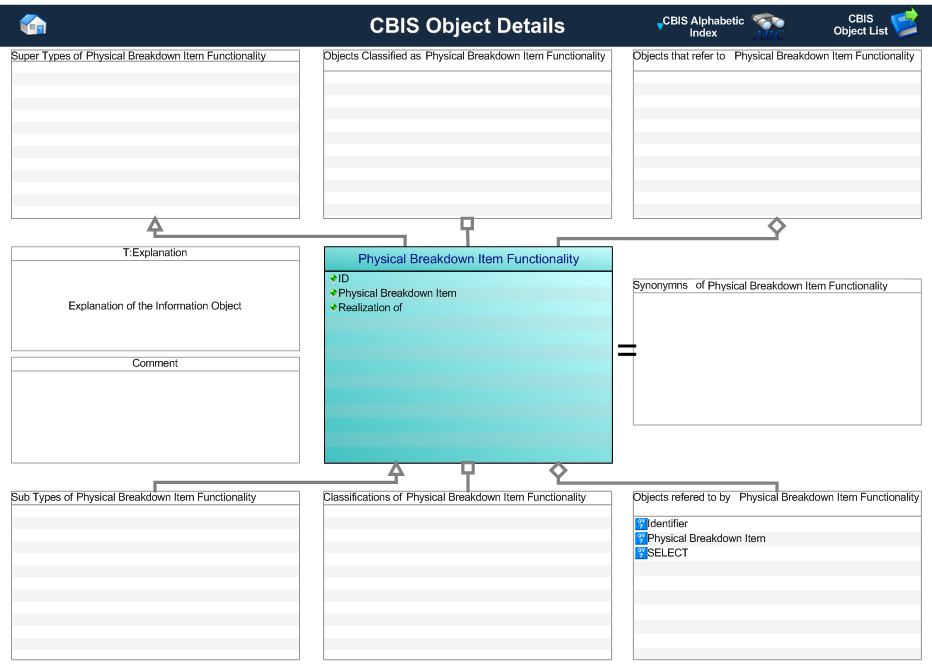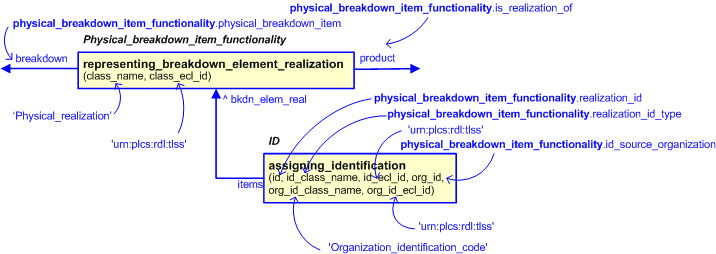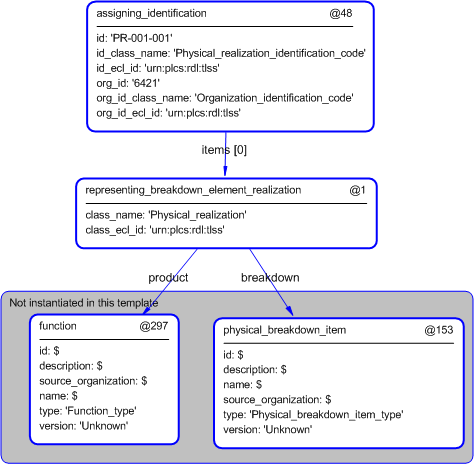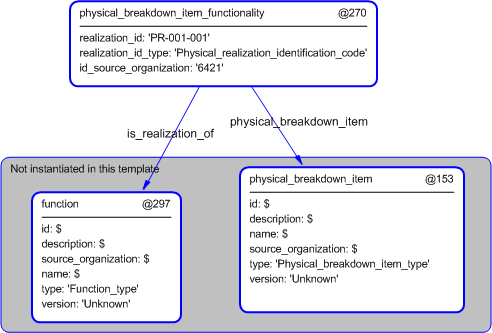Template:— physical_breakdown_item_functionality (phys_bkdn_fnct)
Context:— UK_Defence |
Date: 2009/04/17 10:29:33
Revision: 1.2
|
This section specifies the template physical_breakdown_item_functionality.
NOTE
The template has been defined in the context of
UK_Defence.
Refer to the business context for details of related templates.
NOTE
An explanation of a template and the associated instantiation path is
provided in the
Template overview
section.
This template describes how to reference the functionality realized by a physical item.
This information object represents the realization of a function by a physical item.
This information object defines the realization of a function by a physical item.
Figure 1 — Graphical Representation for Business Object Physical Breakdown Item Functionality
|
Attribute name
|
Attribute description
|
Attribute type
|
Optionality
|
| id |
This attribute provides the identification of the breakdown item. |
Identifier |
Mandatory |
| Identifier.id |
This is the value of the id attribute of the Identifier applied to the Physical Breakdown Item Functionality. |
intrinsic |
Mandatory |
| Identifier.type |
This attribute is the type associated with the id of the Identifier given to the Physical Breakdown Item Functionality. This
attribute indicates the type of functional items covered by the breakdown. This must be one of the classes provided.
|
Physical_realization_identification_code |
Mandatory |
| Identifier.source_organization |
This attribute is the value representing the source organization that provides the id of the Identifier given to the Physical
Breakdown Item Functionality. This value is assumed to be a type of Organization_identification_code.
|
Organization_identification_code |
Mandatory |
| Realization_of |
This attribute provides the reference to the function that the related physical breakdown element has been designed to fulfill. |
Function |
Mandatory |
| Physical_breakdown_item |
This attribute provides the reference to the physical breakdown item that has been designed to meet the requirments of the
related functions.
|
Relationship to Physical_breakdown_item |
Mandatory |
Table 1 — physical_breakdown_item_functionality attribute details
The EXPRESS-G diagram in
Figure
2
shows the templates and EXPRESS entities that are required
to represent the template
"physical_breakdown_item_functionality".
The text highlighted in blue shows the template parameters.
Figure 2 — An EXPRESS-G representation of the Information model for physical_breakdown_item_functionality
The graphic for the template to be used in other EXPRESS-G diagrams
is shown in Figure
3
below.
Figure 3 — The graphical representation of the physical_breakdown_item_functionality template
The following input parameters are defined for this template:
This is the identifier of the physical breakdown item functionality relationship
This attribute is provides the type associated with the id of the Identifier given to the relationship. This must
be one of the classes provided.
The following classes and their sub-classes can be used:
classifications: [Physical_realization_identification_code]![[warning:]](../../../../../../images/dex/warning.gif) Error RDL4: The URI urn:plcs:rdl:uk_defence is not listed in dexlib/data/refdata/rdl_index.xml
Error RDL4: The URI urn:plcs:rdl:uk_defence is not listed in dexlib/data/refdata/rdl_index.xml
The Organization_identification_code identifier of the organization that owns the id.
This is the physical breadkdown element definition that is realizing the function.
The functional element definition being realized.
The following reference parameters are defined for this template:
Allow the
View_definition_usage
entity instantiated in this path to be referenced when this template is used.
%^target = $physical_breakdown_item_functionality.realization_relationship%
The instantiation path shown below specifies the entities that are to be
instantiated by the template.
A description of templates and the syntax for the instantiation path is
provided in the
Templates Help/Information section.
/
representing_breakdown_element_realization(
breakdown=@physical_breakdown_item,
product=@is_realization_of,
class_name='Physical_realization',
class_ecl_id='urn:plcs:rdl:uk_defence')/
%^realization_relationship = $representing_breakdown_element_realization.bkdn_elem_real%
-- assign name to breakdown_element /
assigning_identification(
id=@realization_id,
id_class_name=@realization_id_type,
id_ecl_id='urn:plcs:rdl:uk_defence',
org_id=@id_source_organization,
org_id_class_name='Organization_identification_code',
org_id_ecl_id='urn:plcs:rdl:uk_defence',
items=^realization_relationship)/
The instance diagram in Figure
4
shows an example of the EXPRESS entities and templates that are instantiated by the template:
/physical_breakdown_item_functionality(realization_id='PR-001-001', realization_id_type='Physical_realization_identification_code', id_source_organization='6421', physical_breakdown_item='@297', is_realization_of='@153')/
(an illustration of the consolidated physical_breakdown_item_functionality template is shown in
Figure
5 below.)
Figure 4 — Entities instantiated by physical_breakdown_item_functionality template
The instance diagram in
Figure
5
shows the graphic symbol for the template that is to be
used in other instance diagrams. The example template is:
/physical_breakdown_item_functionality(realization_id='PR-001-001', realization_id_type='Physical_realization_identification_code', id_source_organization='6421', physical_breakdown_item='@297', is_realization_of='@153')/
Figure 5 — Instantiation of physical_breakdown_item_functionality template
Characterizations
No common characterizations of the template
physical_breakdown_item_functionality
have been identified. However, the ISO 10303-239 EXPRESS model
may enable other assignments to the entities instantiated by the template.




